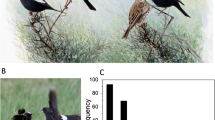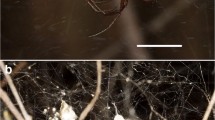Abstract
Previous studies on tree crickets have demonstrated female choice of males based on size and courtship feeding but less is known about sexual selection under conditions of direct mating competition. I studied courtship, aggression and mating of the black-horned tree cricket Oecanthus nigricornis (Walker) to test size-related sexual selection under conditions of direct sexual competition. Results show that larger individuals of both sexes mated more frequently than their smaller counterparts, and this was due to the ability of large individuals to out compete rivals. Large males achieved the advantage by aggressively reducing courtship by small males, whereas large females responded to male courtship more quickly but with little aggression. Although there was no evidence here for mate choice, there were advantages for having larger mates; fecundity increased with female size and spermatophores (which females consume after mating) increased with male size. Size of the specialized metanotal courtship gift, however, was not related to male size.


Similar content being viewed by others
References
Alexander RD (1961) Aggressiveness, territoriality and sexual behavior in field crickets (Orthoptera: Gryllidae). Behaviour 17:130–223
Alexander RD, Otte D (1967) The evolution of genitalia and mating behavior in crickets (Gryllidae) and other Orthoptera. Misc Publ Mus Zool, Univ Michigan 133:7–62
Bell PD (1980) Multimodal communication by the black-horned tree cricket, Oecanthus nigricornis (Walker) (Orthoptera: Gryllidae). Can J Zool 58:1861–1868
Boldyrev BT (1927) Copulation and spermatophores of Gryllomorpha dalmatina (Oesk.) (Orth. Gryllidae). Eos 3:279–288
Bonduriansky R (2001) The evolution of male mate choice in insects: a synthesis of ideas and evidence. Biol Rev 76:305–339
Brown WD (1990a) Size-assortative mating in the blister beetle Lytta magister (Coleoptera: Meloidae) is due to male and female preference for larger mates. Anim Behav 40:901–909
Brown WD (1990b) Constraints on size-assortative mating in the blister beetle Tegrodera aloga (Coleoptera: Meloidae). Ethology 86:146–160
Brown WD (1997a) Courtship feeding in tree crickets increases insemination and female reproductive life span. Anim Behav 54:1369–1382
Brown WD (1997b) Female remating and the intensity of female choice in black-horned tree crickets, Oecanthus nigricornis. Behav Ecol 8:66–74
Brown WD (1999) Mate choice in tree crickets and their kin. Ann Rev Entomol 44:371–396
Brown WD, Gwynne DT (1997) Evolution of mating in crickets, katydids and wetas (Ensifera). In: Gangwere SK, Muralirangan MC, Muralirangan M (eds) Bionomics of grasshoppers, katydids and their kin. CAB International, Wallingford, UK, pp 281–314
Brown WD, Kuns MM (2000) Female choice and the consistency of courtship feeding in black-horned tree crickets Oecanthus nigricornis Walker (Orthoptera: Gryllidae: Oecanthinae). Ethology 106:543–557
Brown WD, Stanford R (1992) Male mating tactics in a blister beetle (Coleoptera: Meloidae) vary with female quality. Can J Zool 70:1652–1655
Brown WD, Chimenti AJ, Siebert JR (2007) The payoff of fighting in house crickets: motivational asymmetry increases male aggression and mating success. Ethology 113:457–465
Brown WD, Smith AT, Moskalik B, Gabriel J (2006) Aggressive contests in house crickets: size, motivation and the information content of aggressive songs. Anim Behav 72:225–233
Brown WD, Wideman J, Andrade MCB, Mason AC, Gwynne DT (1996) Female choice for an indicator of male size in the song of the black-horned tree cricket, Oecanthus nigricornis (Orthoptera: Gryllidae: Oecanthinae). Evolution 50:2400–2411
Burk T (1983) Aggression and female choice in a field cricket (Teleogryllus oceanicus): the importance of courtship song. In: Gwynne DT, Morris GK (eds) Orthopteran mating systems: sexual competition in a diverse group of insects. Westview, Boulder. CO, pp 97–119
Bussière LF, Basit HA, Gwynne DT (2005a) Preferred males are not always good providers: female choice and male investment in tree crickets. Behav Ecol 16:223–231
Bussière LF, Clark AP, Gwynne DT (2005b) Precopulatory choice for cues of material benefits in tree crickets. Behav Ecol 16:255–259
Dixon KA, Cade WH (1986) Some factors influencing male–male aggression in the field cricket Gryllus integer (time of day, age, weight and sexual maturity). Anim Behav 34:340–346
Dodson GN, Morris GK, Gwynne DT (1983) Mating behavior of the primitive orthopteran genus Cyphoderris (Haglidae). In: Gwynne DT, Morris GK (eds) Orthopteran mating systems: sexual competition in a diverse group of insects. Westview, Boulder, CO, pp 305–318
Fulton BB (1915) Tree crickets of New York: life history and bionomics. New York Agricultural Experiment Station Technical Bulletin 42:3–47
Gage MJG (1998) Influences of sex, size, and symmetry on ejaculate expenditure in a moth. Behav Ecol 9:592–597
Gwynne DT (1981) Sexual difference theory: Mormon crickets show role reversal in mate choice. Science 213:779–780
Gwynne DT (1982) Mate selection by female katydids (Orthoptera: Tettigoniidae, Conocephalus nigropleurum). Anim Behav 30: 734-738
Gwynne DT (1990) Testing parental investment and the control of sexual selection in katydids: the operational sex ratio. Am Nat 136:474–484
Gwynne DT (1997) The evolution of edible ‘sperm sacs’ and other forms of courtship feeding in crickets, katydids and their kin (Orthoptera: Ensifera). In: Choe JC, Crespi BT (eds) The evolution of mating systems in insects and arachnids. Cambridge Univ. Press, Cambridge, UK, pp 110–129
Gwynne DT, Morris GK (1983) Orthopteran mating systems: sexual selection in a diverse group of insects. Westview Press, Boulder
Hack MA (1997) Assessment strategies in the contests of male crickets, Acheta domesticus (L.). Anim Behav 53:733–747
Kvarnemo C, Simmons LW (1999) Variance in female quality, operational sex ratio and male mate choice in a bushcricket. Behav Ecol Sociobiol 45:245–252
Lynam AJ, Morris S, Gwynne DT (1992) Differential mating success of virgin female katydids Requena verticalis (Orthoptera: Tettigoniidae). J Insect Behav 5:51–59
Mays DL (1971) Mating behavior of nemobine crickets Hygronemobius, Nemobius and Pteronemobius (Orthoptera: Gryllidae). Fla Entomol 54:113–126
Nelson CM, Nolen TG (1997) Courtship song, male agonistic encounters, and female choice in the house cricket, Acheta domesticus (Orthoptera: Gryllidae). J Insect Behav 10:557–570
Otte D, Cade WH (1976) On the role of olfaction in sexual and interspecies recognition in crickets (Acheta and Gryllus). Anim Behav 24:1–6
Parker GA, Simmons LW (1989) Nuptial feeding in insect: theoretical models of male and female interests. Ethology 82:3–26
Rutowski RL (1982) Mate choice and lepidopteran mating behavior. Fla Entomol 65:72–82
Sakaluk SK (1984) Male crickets feed females to ensure complete sperm transfer. Science 223:609–610
Sakaluk SK, Smith RL (1988) Inheritance of male parental investment in an insect. Am Nat 132:594–601
Sakaluk SK, Campbell MTH, Clark AP, Johnson JC, Keorpes PA (2004) Hemolymph loss during nuptial feeding constrains male mating success in sagebrush crickets. Behav Ecol 15:845–849
Savage KE, Hunt J, Jennions MD, Brooks R (2005) Male attractiveness covaries with fighting ability but not with prior fight outcome in house crickets. Behav Ecol 16:196–200
Shackleton MA, Jennions MD, Hunt J (2005) Fighting success and attractiveness as predictors of male success in the black field cricket, Teleogryllus commodus: the effectiveness of no-choice tests. Behav Ecol Sociobiol 58:1–8
Simmons LW (1986a) Inter-male competition and mating success in the field cricket, Gryllus bimaculatus (DeGeer). Anim Behav 34:567–579
Simmons LW (1986b) Female choice in the field cricket Gryllus bimaculatus (DeGeer). Anim Behav 34:1463–1470
Simmons LW (1990) Nuptial feeding in tettigoniids: male costs and the rates of fecundity increase. Behav Ecol Sociobiol 27:43–47
Tachon G, Murray A-M, Gray D, Cade WH (1999) Agonistic displays and the benefits of fighting in the field cricket, Gryllus bimaculatus. J Insect Behav 12:533–543
Thornhill R (1976) Sexual selection and paternal investment in insects. Am Nat 110:153–163
Thornhill R, Alcock J (1983) Evolution of insect mating systems. Harvard University Press, Cambridge
Trivers RL (1972) Parental investment and sexual selection. In: Campbell B (ed) Sexual selection and the descent of man. 1872–1971. Aldine, Chicago, pp 136–179
Vahed K (1998) The function of nuptial feeding in insects: a review of empirical studies. Biol Rev 73:43–78
Vahed K (2006) Larger ejaculate volumes are associated with a lower degree of polyandry across bushcricket taxa. Proc R Soc Lond B 273:2387–2394
Walker TJ (1978) Post-copulatory behavior of the two-spotted tree cricket, Neoxabea bipunctata. Fla Entomol 61:39–40
Walker TJ, Gurney AB (1967) The metanotal gland as a taxonomic character in Oecanthus of the United States. Proc Entomol Soc Wash 69:157–161
Zuk M, Simmons LW (1997) Reproductive strategies of the crickets (Orthoptera: Gryllidae). In: Choe JC, Crespi BJ (eds) The evolution of mating systems in insects and arachnids. Cambridge Univ. Press, Cambridge, UK, pp 89–109
Acknowledgments
This work was supported by an NSERC operating grant to Darryl Gwynne. Special thanks to R. Baker, D. Gwynne, and the reviewers for comments on the manuscript.
Author information
Authors and Affiliations
Corresponding author
Rights and permissions
About this article
Cite this article
Brown, W.D. Size-biased Mating in Both Sexes of the Black-horned Tree Cricket, Oecanthus nigricornis Walker (Orthoptera: Gryllidae: Oecanthinae). J Insect Behav 21, 130–142 (2008). https://doi.org/10.1007/s10905-007-9112-1
Revised:
Accepted:
Published:
Issue Date:
DOI: https://doi.org/10.1007/s10905-007-9112-1




